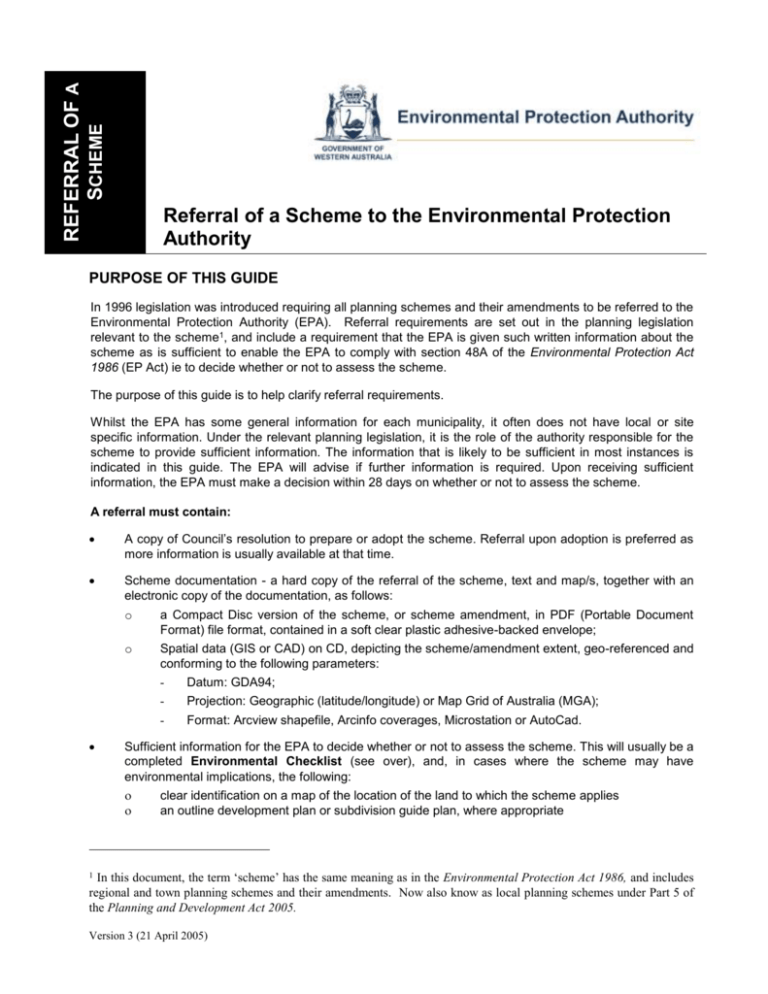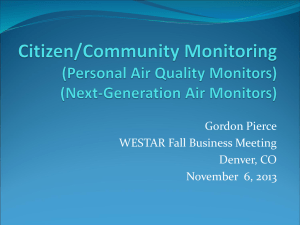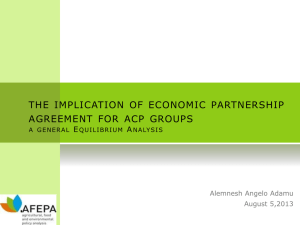FORM: Referral of a scheme - Environmental Protection Authority
advertisement

REFERRAL OF A SCHEME Referral of a Scheme to the Environmental Protection Authority PURPOSE OF THIS GUIDE In 1996 legislation was introduced requiring all planning schemes and their amendments to be referred to the Environmental Protection Authority (EPA). Referral requirements are set out in the planning legislation relevant to the scheme1, and include a requirement that the EPA is given such written information about the scheme as is sufficient to enable the EPA to comply with section 48A of the Environmental Protection Act 1986 (EP Act) ie to decide whether or not to assess the scheme. The purpose of this guide is to help clarify referral requirements. Whilst the EPA has some general information for each municipality, it often does not have local or site specific information. Under the relevant planning legislation, it is the role of the authority responsible for the scheme to provide sufficient information. The information that is likely to be sufficient in most instances is indicated in this guide. The EPA will advise if further information is required. Upon receiving sufficient information, the EPA must make a decision within 28 days on whether or not to assess the scheme. A referral must contain: A copy of Council’s resolution to prepare or adopt the scheme. Referral upon adoption is preferred as more information is usually available at that time. Scheme documentation - a hard copy of the referral of the scheme, text and map/s, together with an electronic copy of the documentation, as follows: o a Compact Disc version of the scheme, or scheme amendment, in PDF (Portable Document Format) file format, contained in a soft clear plastic adhesive-backed envelope; o Spatial data (GIS or CAD) on CD, depicting the scheme/amendment extent, geo-referenced and conforming to the following parameters: - Datum: GDA94; - Projection: Geographic (latitude/longitude) or Map Grid of Australia (MGA); - Format: Arcview shapefile, Arcinfo coverages, Microstation or AutoCad. Sufficient information for the EPA to decide whether or not to assess the scheme. This will usually be a completed Environmental Checklist (see over), and, in cases where the scheme may have environmental implications, the following: clear identification on a map of the location of the land to which the scheme applies an outline development plan or subdivision guide plan, where appropriate In this document, the term ‘scheme’ has the same meaning as in the Environmental Protection Act 1986, and includes regional and town planning schemes and their amendments. Now also know as local planning schemes under Part 5 of the Planning and Development Act 2005. 1 Version 3 (21 April 2005) information on relevant items in the environmental checklist (see over) when electronic documentation is not available, additional copies of the scheme documentation for the EPA Service Unit to forward to the Department of Environment and Conservation and other agencies for technical advice. The EPA Service Unit’s Planning and Infrastructure Branch can advise on referral requirements and issues of environmental significance. Liaison with the EPA Service Unit may be particularly helpful in the following instances - schemes raising potentially significant environmental issues and whole-of-municipality town planning schemes. The Planning and Infrastructure Branch can be contacted by ringing 6364 6500 and asking for an environmental officer who deals with the region. Version 3 (21 April 2005) Referral of a scheme to the Environmental Protection Authority ENVIRONMENTAL CHECKLIST Title of scheme*: _______________________________________________ This checklist is intended to assist authorities responsible for schemes to identify potential environmental issues, and to supply the information that the EPA requires to decide whether or not to assess a scheme. Please tick the appropriate box and supply the information indicated at Section D below to the EPA. For clarification of any terms or descriptions used, please refer to EPA Guidance No. 33 “Environmental Guidance for Planning and Development” through the EPA website or the Planning and Infrastructure Assessments Branch of the EPA Service Unit. A. Biophysical factors Yes No Unsure 1. Does the area to which the scheme applies contain or adjoin any of the following? a) bushland. If yes, identify b) a wetland (includes seasonally damp land), watercourse or river - if yes, identify c) an estuary or inlet. If yes, identify d) coastal area or near-shore marine area. If yes, identify e) a public water supply area. If yes, identify f) a landform of special interest, for example, karst, beach ridge plain. If yes, identify □ □ □ □ □ □ □ □ □ □ □ □ □ □ □ □ □ □ □ □ □ □ □ 2. Is any area to which the scheme applies in a catchment that is of particular environmental concern or interest? If yes, identify the catchment: Lake Clifton catchment Swan Coastal Plain catchment of the Peel–Harvey Estuary Swan and Canning Rivers catchment (other than Ellenbrook catchment) Ellenbrook catchment Other catchment (please name) □ □ □ □ □ 3. Is the land to which the scheme applies the subject of any significant or potentially significant soil or land degradation issues, for example, salinity, waterlogging, erosion, acid sulphate soil? □ If yes, identify issue/s: B. Pollution management 4. Does the scheme allow for a land use that will or could discharge a significant quantity of a potential pollutant to the air, surface water, soil or groundwater? If yes, please identify the land use/s, and associated pollutants: Version 3 (21 April 2005) □ □ □ Yes No Unsure 5. Does the scheme allow for a land use that could require a buffer over adjoining land? that is, does it allow for uses that may affect adjoining land (including land that may be □ □ □ 6. Would the scheme allow a residential area or sensitive land use (e.g. school) to be located in an area likely to be affected by emissions (e.g. gases, noise, odour) from industry, agriculture or infrastructure (e.g. landfill site)? If yes, please identify: □ □ □ 7. Does the scheme apply to a site that has been used for a past land use which may have contaminated the soil or groundwater, for example, market garden, industrial use, fill? If yes, please identify: □ □ □ 8. Does the scheme apply to any land with a high watertable? □ □ □ □ □ □ □ □ □ □ □ □ □ □ □ used for future residential use) due to gases, noise, vibration, odours, light? If yes, please identify land use/s, and off-site areas that may be affected: What is the distance to the nearest residences? □ C. Social surroundings 9. Does the scheme raise any issues known to be of concern to the public? If yes, is the concern to the public related to an environmental issue? Please specify the environmental issue(s) of concern 10. Is the scheme likely to raise heritage or cultural issues due to impacts on the biophysical environment? If yes, please identify 11. Does the scheme apply to areas of land where there are existing or potential land uses associated with high levels of risk, for example, a high pressure gas pipe line, heavy industry? If yes, please identify: D. Additional information If all answers to the questions above are “no”, no other environmental information is required to accompany this checklist. If answers include “yes” or “unsure”, please provide information for those items on: o the existing environment o potential environmental impacts and their magnitude/significance o how the impacts will be managed to ensure a good environmental outcome. The EPA will review the checklist and information submitted and if not sufficient for the EPA to decide whether or not to assess the scheme, the EPA may request additional information. Name of person completing form: Position: Version 3 (21 April 2005) Date: Contact Phone/Email:







